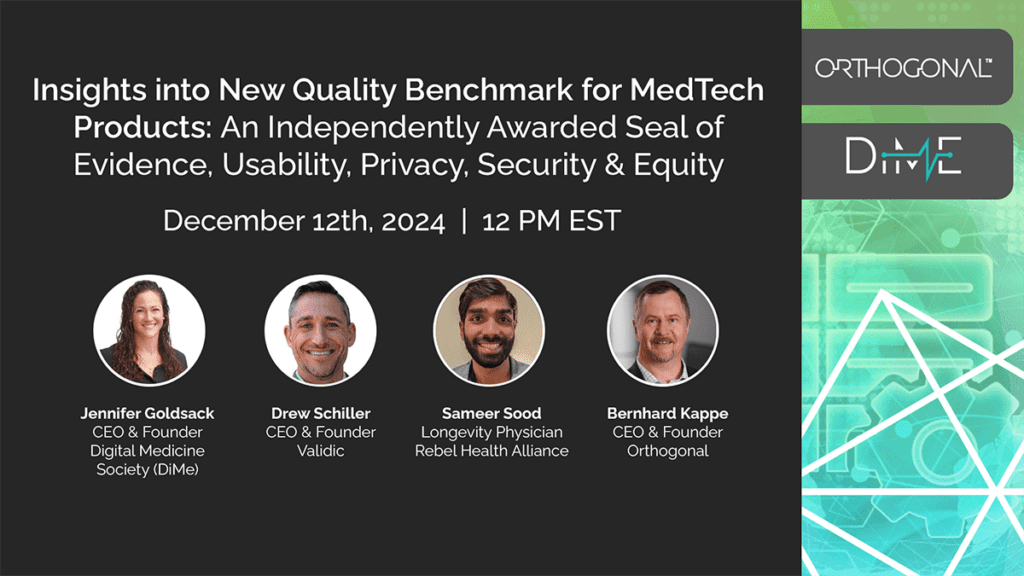
Talk
Lessons Learned from 2025, Plans for 2026 for Digital

As medical device software, Software as a Medical Device (SaMD), and Digital Therapeutics (DTx) become more prevalent, patients, providers and payers need a reliable way to identify quality products that have been vetted for evidence, usability, privacy, security and equity. How can MedTech companies best communicate to stakeholders that their products are trustworthy in this increasingly complex and oft-confusing marketplace?
Orthogonal and the Digital Medicine Society (DiME), a non-profit organization dedicated to advancing digital medicine to optimize human health, held a webinar on December 12th, 2024 that explored the newly-launched DiMe Seal – a symbol of quality awarded by an independent governance committee to digital health software products.
In this conversation, DiMe CEO Jen Goldsack, CEO of Validic, Drew Schiller, and Sameer Sood, Longevity Physician at Rebel Health Alliance, Medical Department Head and Intellectual & Developmental Disability Primary Care Physician at Kramer Davis Health, and CEO at FwdSlash, shared insights into the rapidly evolving digital health tools landscape, highlighting the pressing need for a clear, unified definition of quality standards. The discussion explored how the DiMe Seal is designed to address these challenges by setting a benchmark for what ‘good’ looks like, empowering stakeholders across healthcare to identify and trust effective, reliable digital health solutions. By fostering transparency and consistency, the DiMe Seal intends to streamline processes for health systems and providers, ultimately enhancing the patient experience.
The webinar served as an opportunity for MedTech professionals to learn about this new initiative, its potential impact on our industry and emerging trends in quality assurance of digital health software products, which includes SaMD, DTx and medical device software.
In today’s digital health landscape, it can often feel like trying to pick your way through a cluttered bazaar—endless products shouting for attention, each promising that it’s the next must-have solution for patients, clinicians, or payers. The sheer volume of digital health tools, from Software as a Medical Device (SaMD) to Digital Therapeutics (DTx) and patient-facing wellness apps to intricate clinical decision support systems, makes it challenging to separate enduring quality from temporary hype. Everyone wants to know: Is this product genuinely effective and trustworthy, or is it just making unproven claims?
This problem is not theoretical. As we embrace digital health and connected medical device software more deeply, the consequences of choosing low-quality or unproven tools multiply. Clinicians grow frustrated with platforms that overpromise and underdeliver, patients lose trust in solutions that fail to produce meaningful results, and payers struggle to identify which products warrant investment. Meanwhile, developers who genuinely build robust, evidence-based solutions find their voices drowned out by the chaotic marketplace.
These challenges have triggered a pressing question: How can stakeholders—especially healthcare professionals, health systems, payers, and ultimately, patients—clearly recognize the quality of digital health products? Enter the DiMe Seal, a newly launched quality benchmark introduced by the Digital Medicine Society (DiMe).
During the webinar hosted by Orthogonal, representatives from the Digital Medicine Society, Validic, and other industry leaders convened to address the confusion and skepticism permeating digital health. The problem is profound and persistent: Not every “digital health” product is evidence-based or carefully engineered. While some developers focus intently on quality, others may lack a deep understanding of healthcare’s complexity or willingly push products with insufficient testing or overreaching claims.
Orthogonal’s Randy Horton highlighted the gravity of this challenge: in an environment with so many offerings, who can clinicians, payers, and patients trust? Jennifer Goldsack, CEO and Founder of DiMe underscored the urgency. Healthcare, she explained, is the last big industry to be digitized, and as it moves into a complex digital era, we must be careful. We can’t rely solely on regulators or policies because those frameworks, while critical, only address part of the puzzle. The sector needs a comprehensive system to identify and endorse the baseline “table stakes” of what makes a digital health product trustworthy, usable, equitable, and secure.
The DiMe Seal emerges as a central player in solving this puzzle. This seal is not a casual stamp of approval; it’s a formal recognition that a digital health software product meets carefully defined standards across essential domains such as evidence, privacy, security, usability, and equity. Think of it as “consumer reports” for digital health solutions. As consumer advocacy organizations set benchmarks to help buyers distinguish quality appliances or automobiles, the DiMe Seal sets a benchmark for differentiating reliable digital health products from noise.
Unlike regulatory frameworks focused on safety and effectiveness for specific intended uses—as in FDA-clearance for certain medical devices—the DiMe Seal applies to a broad spectrum of digital health software. Whether it’s a patient-facing wellness app, a care management platform that integrates with clinical workflows, or software enabling data sharing for chronic disease management, the seal aims to hold all these to a transparent, actionable standard.
Quality in digital health doesn’t hinge on one attribute alone. The DiMe Seal’s criteria cover multiple domains defining a reliable, impactful product. Jennifer Goldsack explained that these standards were developed with extensive input from leaders across the field—clinicians, health systems, developers, payers, and patients—to capture the true essence of “good.”
Evidence: Validating Claims
A pivotal requirement is that products must support their claims with verifiable evidence. For instance, if a platform states that it reduces patient visits to the emergency room, improves chronic disease outcomes, or streamlines clinic workflows, it can’t just say so—it must show so. The DiMe Seal expects concrete data, study results, regulatory clearances (where relevant), or clinical validations, proving the solution delivers its promises.
This requirement helps sift out wishful thinking and empty marketing. Developers who have already undergone rigorous processes, such as a successful FDA 510(k) for SaMD, can leverage that clearance. Such existing regulatory approvals can help them “test out” certain sections within the DiMe evaluation, reducing redundancy while still preserving high standards.
Privacy & Security: Protecting Patients and Systems
Healthcare data is sensitive by nature, and its mishandling isn’t just a technical issue—it’s a patient safety concern. The DiMe Seal’s privacy and security criteria aim to ensure that products treat patient data as securely as regulated entities do, even if a particular product doesn’t fall strictly under regulatory oversight.
Robust privacy policies written at a level users can understand, secure data transmission methods and strong cybersecurity measures are all table stakes. DiMe recognizes existing high-bar frameworks, such as SOC 2 or HITRUST certifications. A product with one of these certifications can “test out” some security criteria. Developers without these certifications can still prove their security posture through Seal’s framework, receiving guidance on what improvements to make.
Usability & Inclusivity: Making Good Technology Work for Everyone
A high-quality digital health product must be usable by seasoned clinicians juggling multiple platforms and patients with diverse abilities, levels of health literacy, and technological comfort. Usability isn’t an afterthought; it’s central to ensuring that the product’s benefits can be realized in everyday contexts.
DiMe Seal evaluators ask, for example, if a solution meets accessibility standards, can integrate seamlessly into a clinician’s workflow without adding burdens, and can serve populations that may be marginalized or have specialized needs. Inclusivity and equity are woven into all aspects of evaluation—from how privacy policies are drafted to how the interface is designed, ensuring that no segment of the population is left behind.
One critical design choice for the DiMe Seal process is emphasizing support and improvement rather than “naming and shaming.” If a product doesn’t meet a specific criterion right away, it doesn’t get publicly rejected or blacklisted. Instead, the DiMe team provides coaching and guidance, helping developers identify where to improve.
This constructive approach acknowledges that the digital health ecosystem is still evolving. Some early-stage products might not yet have the resources for expensive certifications or the experience to design privacy policies at an 8th-grade reading level. Rather than excluding these innovators, the DiMe Seal encourages them to build better products over time. The Seal’s criteria serve as a roadmap for continuous quality improvement.
Drew Schiller of Validic, whose platform was among the first to earn the DiMe Seal, explained that when an organization already practices robust development principles, meeting the Seal’s standards is straightforward. Conversely, a startup that lacks specific documentation or well-defined processes for privacy or usability can view this as an actionable blueprint, guiding them toward best practices they may not have fully considered.
Developers aren’t the only ones who benefit from the DiMe Seal. Healthcare systems, payers, and clinicians constantly review potential digital tools, often struggling to separate meaningful innovation from empty marketing claims. The Seal narrows the top of the funnel, doing some due diligence in advance. If a product appears on the DiMe Seal’s list of approved solutions, it signals to decision-makers that it has passed a credible, independent review.
Sameer Sood, a practicing physician, emphasized how the Seal can help clinicians who face a deluge of new devices and apps. Instead of personally testing tools to see if they genuinely work or wading through complex technical documents, healthcare professionals could rely on the DiMe Seal as an external, trusted quality indicator. This spares clinicians from guesswork and frees them to focus on what matters—patient care.
Similarly, patients stand to benefit. As DiMe conducts patient education and outreach, individuals using digital health solutions can learn to look for the Seal as a mark of integrity. A patient considering a new tool to help manage a chronic condition can have greater confidence that the product has undergone serious scrutiny, addressing concerns about privacy, reliability, and usability before they even install the app.
The team behind the DiMe Seal carefully designed it to minimize unnecessary duplication of effort. If a product has earned recognized quality certifications or regulatory clearances, it can leverage those achievements to meet relevant Seal criteria. For example, a company with a well-established SOC 2 or HITRUST certification can skip re-proving their security up to par. Similarly, an FDA clearance can go a long way toward fulfilling evidence requirements.
This approach honors prior hard work while ensuring that every criterion—evidence, privacy, security, and usability—is thoroughly vetted. The result is a balanced system that’s both rigorous and efficient.
DiMe’s initiative didn’t emerge in isolation. The project’s success comes from deep involvement with key players throughout the industry. The community behind the Seal includes developers like Validic, clinical voices like Sameer Sood, and strategic minds at Orthogonal who see firsthand how challenging it is to build “good” digital health software that stands out.
According to Goldsack, creating the DiMe Seal required bringing diverse experts to the table. Their multi-stakeholder approach ensures that the criteria are not divorced from reality but reflect the actual needs, pressures, and incentives in healthcare today.
This means the Seal isn’t just an academic exercise—it’s a practical tool meant to serve the real-world marketplace. As the industry continues to evolve, DiMe can iterate annually, updating benchmarks to keep pace with technological advances, standards shifts, and lessons learned from developers and users alike.
A crucial question that emerged during the conversation was how DiMe would prevent becoming an unwitting “kingmaker” or causing market damage through an overly harsh approach. The example of “consumer reports” for cars was raised to illustrate potential pitfalls, where a misapplied or unfair test can unjustly destroy a product’s reputation.
DiMe aims to prevent such issues by maintaining transparency in the benchmarks and applying them consistently. No surprise criteria were invented on the spot for one developer and not for another. Standards are publicly available, stable, and updated methodically. Also, DiMe does not publicly shame those who fail to meet the standards on their first try. Instead, it focuses on celebrating those who achieve the Seal and quietly guiding those who do not yet qualify toward improvements.
This approach creates an environment that fosters trust and collaboration rather than fear or antagonism. Developers know what to expect, and buyers know that successful candidates have met a known public benchmark.
The long-term promise of the DiMe Seal is that it will become an accelerator for market adoption. Drew Schiller noted that without clear standards, health systems might waste time differentiating between products that only claim deep clinical integration and those that have genuinely invested in seamless workflows. With the Seal, those who have worked hard to integrate correctly, evidence their value, and secure data can surface more readily.
The greater the acceptance of the DiMe Seal in the marketplace, the more it drives upward pressure on quality. As leading payers and health systems insist on the Seal as a baseline, developers must move beyond superficial claims. Over time, this raises the industry’s overall standard, making it less cluttered with half-baked solutions and more abundant in products that genuinely improve patient outcomes, clinician efficiency, and system sustainability.
One of the Seal’s advantages is its adaptability to various product maturities. An established company might earn the Seal swiftly, reaping the reputational and competitive benefits. A younger developer, lacking certain validations, can treat the Seal’s criteria like a to-do list, investing in the necessary improvements and ultimately improving their product.
In this way, the DiMe Seal isn’t just a static hallmark of quality. It’s also an educational and developmental framework. By engaging with DiMe’s guidance, companies learn how to meet privacy and usability standards, integrate meaningful evidence, and improve their code so as not to bring down a clinical workflow upon updating. It’s a process of continuous learning and evolution.
While the webinar’s main focus was the current state of digital health quality evaluation, the conversation hinted at future challenges. For example, the industry grapples with complex technologies like AI-driven diagnostics. Though the DiMe Seal currently emphasizes universal standards like evidence and usability, future updates might incorporate more specialized criteria as the industry’s understanding of new technologies matures.
Participants acknowledged that setting standards in a fast-evolving field is tricky. However, the very existence of the DiMe Seal shows that healthcare can collaboratively shape digital health’s future. By continually refining what “quality” means as technology changes, DiMe’s approach can anticipate and adapt to challenges that were unthinkable just a few years ago.
1. A Unified Benchmark: The DiMe Seal introduces a transparent, multi-dimensional standard that helps distinguish genuinely trustworthy digital health products from untested or inflated claims.
2. Validation Across Domains: Evidence, privacy, security, usability, and equity form a holistic definition of quality. These domains ensure that products are clinically sound but also practical, safe, and accessible.
3. Constructive Improvement: Rather than punishing failure, the process behind the Seal encourages developers to meet the benchmark. This culture of guidance elevates the entire industry over time.
4. Aligning Stakeholders: Providers, payers, and patients benefit from an external validator that reduces uncertainty, fosters trust, and streamlines decision-making.
5. A Roadmap for Growth: Early-stage companies get a path toward quality maturity, while established players can prove their worth and differentiate themselves in a crowded market.
6. Sustainable Impact: By recognizing prior achievements and continuously updating criteria, the DiMe Seal can remain relevant as healthcare evolves and new digital capabilities arise.
The DiMe Seal doesn’t claim to solve every challenge in digital health overnight. Instead, it addresses a foundational problem: how do we know that a given digital health product is truly good? By providing a transparent, attainable benchmark aligned with stakeholder needs, the Seal brings us one step closer to a balanced ecosystem where innovation thrives without sacrificing quality or trust.
From the perspective of companies like Validic, who have already earned the Seal, to clinicians like Sameer Sood, who yearn for clarity and reliable solutions, and strategists like Orthogonal’s team, who have seen the industry struggle with these questions, the DiMe Seal is a beacon. It lights the way forward, guiding products, companies, and entire healthcare systems toward a future in which quality is not an afterthought but the bedrock upon which digital medicine stands
Jen Goldsack, CEO & Founder, Digital Medicine Society (DiMe)
Jennifer C. Goldsack founded and serves as the CEO of the Digital Medicine Society (DiMe), a global non-profit organization dedicated to advancing digital medicine to optimize human health. Jennifer’s research focuses on applied approaches to the safe, effective, and equitable use of digital technologies to improve health, healthcare, and health research. She is a member of the Roundtable on Genomics and Precision Health at the National Academies of Science, Engineering and Medicine and serves on the World Economic Forum Global Leadership Council on mental health.
Drew Schiller, CEO, Validic
Drew Schiller is the founder and CEO of Validic, the leading Health IOT platform for personal health data. He is the immediate past Chair of the Consumer Technology Association (CTA) Health Division Board and a member of the CTA Executive Board. He also contributes to advancing the industry through CTA policy efforts and involvement with the CTA Health Standards Subdivision. Drew is a member of the Highmark Health Technology Advisory Group. He has served as a Board Member at Executives for Health Innovation (eHI), the North Carolina Council for Entrepreneurial Development (CED), and as a Team Member for the Clinical Trials Transformation Institute (CTTI) project Advancing the Use of Mobile Technologies for Data Capture & Improved Clinical Trials. He previously served on the Federal Advisory Committee joint HITPC/HITSC API Task Force on Meaningful Use 3.
Sameer Sood, Longevity Physician at Rebel Health Alliance, Medical Department Head and Intellectual & Developmental Disability Primary Care Physician at Kramer Davis Health, and CEO at FwdSlash
Sameer Sood is an engineer and physician who has created several organizations at the nexus of healthcare and design. As a systems thinker, he’s sought to engage stakeholders in understanding how societal structures, individuals behaviors, psychology and socioeconomic status impact a person’s health and pursuit of meaning.
Bernhard Kappe, CEO and Founder, Orthogonal
Bernhard Kappe is the Founder and CEO of Orthogonal. For over a decade, Bernhard has provided thought leadership and innovation in the fields of Software as a Medical Device (SaMD), Digital Therapeutics (DTx) and connected medical device systems. As a leader in the MedTech industry, Bernhard has a passion for launching successful medical device software that makes a difference for providers and patients, as well as helping companies deliver more from their innovation pipelines. He’s the author of the eBook Agile in an FDA Regulated Environment and a co-author of the AAMI Consensus Report on cloud computing for medical devices. Bernhard was the founder of the Chicago Product Management Association (ChiPMA) and the Chicago Lean Startup Challenge. He earned a Bachelor’s and Masters in Mathematics from the University of Pennsylvania, and a Bachelor’s of Science and Economics from the Wharton School of Business.
Randy Horton, Chief Solutions Officer, Orthogonal
Randy Horton is Chief Solutions Officer at Orthogonal, a software consulting firm that improves patient outcomes faster by helping MedTech firms accelerate their development pipelines for Software as a Medical Device (SaMD), digital therapeutics (DTx) and connected medical device systems. Orthogonal makes that acceleration happen by fusing modern software engineering and product management tools and techniques (e.g., Agile, Lean Startup, User-Centered Design and Systems Thinking) with the regulated focus on device safety and effectiveness that is at the heart of MedTech.
Horton serves as Co-Chair for AAMI’s Cloud Computing Working Group, as well as AAMI CR:510(2021) and the in-process Technical Information Report #115, all of which address how to safely move medical device computing functions into the cloud. He is a frequent speaker at conferences and webinars, including events hosted by AdvaMed, AAMI, HLTH, RAPS and the Human Factors and Ergonomics Society (HFES).
Related Posts

Talk
Lessons Learned from 2025, Plans for 2026 for Digital

Talk
SaMD Development and the Use of AI Tooling

Talk
SaMD, Digital Ecosystems and the New Rules for Cybersecurity

Talk
Medical Device Manufacturers as Providers: A New and Emerging MedTech Model